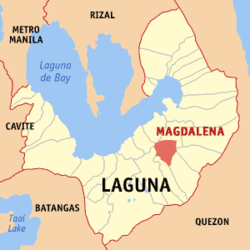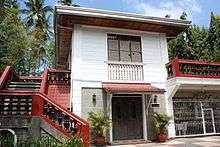Magdalena, Laguna
| Magdalena, Laguna | ||
|---|---|---|
| Municipality | ||
 | ||
| ||
|
Nickname(s): Little Hollywood of Laguna The Bamboo Capital of Laguna | ||
 Map of Laguna showing the location of Magdalena | ||
.svg.png) Magdalena, Laguna Location within the Philippines | ||
| Coordinates: 14°12′N 121°26′E / 14.200°N 121.433°ECoordinates: 14°12′N 121°26′E / 14.200°N 121.433°E | ||
| Country | Philippines | |
| Region | CALABARZON (Region IV-A) | |
| Province | Laguna | |
| District | 4th district of Laguna | |
| Founded | January 18, 1820 | |
| Barangays | 24 | |
| Government[1] | ||
| • Mayor | David Aventurado Jr. | |
| • Vice-Mayor | Constancio Burbos | |
| • Councilors |
List of councilors
| |
| Area[2] | ||
| • Total | 34.88 km2 (13.47 sq mi) | |
| Population (2010)[3] | ||
| • Total | 22,976 | |
| • Density | 660/km2 (1,700/sq mi) | |
| Time zone | PST (UTC+8) | |
| ZIP code | 4007 | |
| Dialing code | 49 | |
| Income class | 4th | |
Magdalena is a fourth class municipality in the province of Laguna, Philippines. According to the 2010 census, it has a population of 22,976 people.[3]
Barangays in Magdalena , Laguna ,Philippines
Magdalena is politically subdivided into 24 barangays.
- Alipit[4]
- Malaking Ambling[5]
- Munting Ambling[6]
- Baanan[7]
- Balanac[8]
- Bucal[9]
- Buenavista[10]
- Bungkol[11]
- Buo[12]
- Burlungan[13]
- Cigaras[14]
- Ibabang Atingay[15]
- Ibabang Butnong[16]
- Ilayang Atingay[17]
- Ilayang Butnong[18]
- Ilog[19]
- Malinao[20]
- Maravilla[21]
- Poblacion[22]
- Sabang[23]
- Salasad[24]
- Tanawan[25]
- Tipunan[26]
- Halayhayin[27]
History
Magdalena was formerly a barrio of Majayjay, Laguna. A petition from the residents of the barrio for the creation of a new town was presented on September 15, 1819. It was proclaimed a new town by Governor General Don Mariano Fernández de Folgueras on January 18, 1820, and was originally named "Magdalena de Ambling". The name was derived from its patron saint Maria Magdalena and the barrio of Ambling where it was established. The first Teniente Alcalde or Capitan (the highest political authority in a town) was Don Mauricio San Mateo.
They first established a makeshift school in 1820, which was the very first requirement for it to be a town. The municipal hall was also constructed. A small chapel was also constructed and it gave way to the construction of a church in 1829. The church was made of stones and bricks and donations were solicited from the residents. The construction was finished in 1861. The construction of the concrete town hall and the church convent started in 1871, and was finished in 1884.
The revolt against the Spaniards in this area started on November 13, 1896, when the male residents joined the revolutionaries from the province to form a bigger force. It was during one of the encounters that Emilio Jacinto was wounded and sought refuge at the Catholic Church.
Emilio Aguinaldo, then, proclaimed the first Philippine Republic and the Spaniards finally surrendered on September 1, 1898, and celebrations followed.
The arrival of the Americans, at the turn of the century, witnessed the evacuation of the townsfolk to the mountains for fear of being killed, later returned to the Poblacion seeing that the foreigners were well-intentioned.
The Americans enforced a new system of government. Election of government officials was conducted regularly. The first elected President Municipal was Don Victor Crisostomo. It was during this time that rebels, called tulisan, formed a force to oppose the foreign rule. They robbed the house of the residents. This made the Americans very strict on social life of the people, prohibiting them from leaving the Poblacion and talking to each other publicly. It was on June 15, 1929 that electricity was introduced in the municipality. Life continued under the American regime and to an extent, introduced their own culture to the Filipinos until the Second World War broke out in 1941.
In 1945, Filipino troops of the 4th, 42nd, 43rd, 45th and 46th Infantry Division of the Philippine Commonwealth Army and 4th Infantry Regiment of the Philippine Constabulary liberated the towns in Magdalena, Laguna. The Japanese surrendered to the Filipino soldiers and guerrillas on May 25, 1945, thus, Magdalena, as well as the Philippines, was liberated from the Japanese army. After the war, they returned to the Poblacion and started their lives from what was left of the war.
Demographics
| Population census of Magdalena | ||
|---|---|---|
| Year | Pop. | ±% p.a. |
| 1990 | 13,450 | — |
| 1995 | 15,927 | +3.22% |
| 2000 | 18,976 | +3.83% |
| 2007 | 20,204 | +0.87% |
| 2010 | 22,976 | +4.79% |
| Source: National Statistics Office[3] | ||
Local government

- Municipal Mayor: Hon. David Aventurado
- Municipal Vice-Mayor: Hon. Constancio Burbos
- Members of the municipal council:
- Henry F. Chua
- Leovio Porcioncula
- Arnel Sune
- Max Sotomayor
- Pedro Bucal
- Boyet Obmerga
- Larry Ibañez
- Elmer Sabado
Tourism



Some notable tourist attractions include:
- St. Mary Magdalene Parish Church
- Mali-Mali Bridge
- Emilio Jacinto Shrine
- The Rizal Park
- The Bahay Laguna
- The Pintong Kabag
- The Pintong Pilak
- Magdalena White Water River Rafting Adventure
- Bahay ni Luz Bed & Breakfast Inn
The Kawayan Festival
Magdalena recently held its first Kawayan Festival to mark the town's 185th Foundation Day. The colorful festival celebrates the native bamboo and its role in the culture and livelihood of the town and to promote bamboo-based industries.
Liga ng mga Barangay national president James Marty Lim was special guest at the festival, and together with Magdalena town officials led by Mayor David Aventurado Jr., congratulated the Magdaleños for their initiatives to promote the local bamboo industry.
However, no such bamboo enterprise visibly exists in the town.
St. Mary Magdalene Parish Church
Santa Maria Magdalena Parish Church|St. Mary Magdalene Church was constructed in 1851-1871, and made of stones and bricks with a sandstone facade. The church is located at the town center or plaza, just across the municipal town hall of Magdalena. In February 1898, after being wounded in a battle with the Spaniards at the Maimpis River, Philippine revolutionary hero Emilio Jacinto sought refuge in this church. His bloodstains were found on the floor of the church.
The Bahay Laguna
Bahay Laguna is a museum in Barangay Bungkol, Magdalena, that houses the memorabilia of Governor Felicisimo T. San Luis, who served as Governor of Laguna province for 33 years. During his time, he was known as the "Living Legend of Laguna." Aside from the memorabilia of the late governor, Bahay Laguna showcases the specialty crafts and signature products of Laguna towns such as woodcarving of Paete and bottled preserved fruits of Alaminos.
The construction of Bahay Laguna was finished in December 1995. The Dr. Floro Brosas Foundation donated a piece of its land for this repository.[28]
Magdalena White Water Rafting Adventure
It's an exciting yet safer 2-hour adventure than the wild river rides of Cagayan, plus its also nearer to Manila. The ride starts at Majayjay river and ends at the dam in Magdalena, Laguna.
Schools

- Elementary
Public:
- Ananias Laico Memorial Elementary School- ALMES(formerly Magdalena Elementary School)
- Ricardo A. Pronove Elementary School- RPES
- Buenavista-Cigaras Elementary School-BCES
- Maravilla Elementary School-MES(Formerly Maravilla Primary School)
- Bungkol Elementary School-BuES
- Balanac Elementary School-BaES
- Secondary
Public:
- Buenavista National High School-(BNHS)
- Magdalena National High School - (MNHS)Formerly BNHS- Annex
Private:
- Banahaw Institute-BI
- College and Vocational
- AMG Skilled Hands Technological College
- Alternative Learning System-Magdalena
- Laguna State Polytechnic University- MAGDALENA Satellite Campus
Magdalena Water System
Potable water should be accessible to all. Working under this belief, the Municipality of Magdalena successfully implemented the LGU Urban Water Supply and Sanitation Project (LGU-UWSSP) in their locality.
In years past, the municipality operated the Magdalena Waterworks, a water supply system which covered ten barangays. The main water source was the Oples Spring in the nearby town of Liliw, Laguna, supplying a volume of four liters/second to 1,097 service connections. Tariff was Php 8.00 for the first 10 cubic meters and an additional Php 1.00 in excess of 10 cubic meters.
However, the people were not keen on increasing the tariff, as the service was extremely poor. Believing that water is one of the basic services that the government should be able to provide to the people, the LGU consequently searched for a more permanent solution. Through the DILG and World Bank, the Local Government Unit Urban Water Supply and Sanitation Project (LGUUWSSP) was introduced to Magdalena officials. Through barangay meetings and consultations, the people came to know of the LGU water project and how it will help address their problems.
With the creation of the Municipal Water Board on August 2004, the water system was also constructed and became fully operational within a period of one year and six months. The Water Board is at present focused in the expansion of the service area to provide quality water service to the nearby barangays. Moreover, the board is continuously producing policies to help the project be self-sufficient and be a profitable economic enterprise for the LGU.
With the successful implementation of the LGU-UWSSP, there have been marked improvements in the water supply and living conditions of the people in the community. All stakeholders in the municipality benefitted from the improved water system. From the previous practice of rationing water, a 24/7 supply has been established, contributing to the improved health of the citizenry.[29]
However, up until now, the drinking water in town still smells like iron and cannot be drank straight from the faucet.
References
- ↑ "Official City/Municipal 2013 Election Results". Intramuros, Manila, Philippines: Commission on Elections (COMELEC). 11 September 2013. Retrieved 20 November 2013.
- ↑ "Province: LAGUNA". PSGC Interactive. Makati City, Philippines: National Statistical Coordination Board. Retrieved 20 November 2013.
- 1 2 3 "Total Population by Province, City, Municipality and Barangay: as of May 1, 2010" (PDF). 2010 Census of Population and Housing. National Statistics Office. Retrieved 20 November 2013.
- ↑ Alipit
- ↑ Malakingambling
- ↑ Muntingambling
- ↑ Baanan
- ↑ Balanac
- ↑ Bucal
- ↑ Buenavista
- ↑ Bungkol
- ↑ Buo
- ↑ Burlungan
- ↑ Cigaras
- ↑ Ibabangatingay
- ↑ Ibabangbutnong
- ↑ Ilayangatingay
- ↑ Ilayangbutnong
- ↑ Ilog
- ↑ Malinao
- ↑ Maravilla
- ↑ Poblacion
- ↑ Sabang
- ↑ Salasad
- ↑ Tanawan
- ↑ Tipunan
- ↑ Halayhayin
- ↑ http://www.lagunatravelguide.com/index.php?page=bahay-laguna-2
- ↑ http://dilgcalabarzon.com/index.php?option=com_content&view=article&id=135&Itemid=150
External links
| Wikimedia Commons has media related to Magdalena, Laguna. |
- Philippine Standard Geographic Code
- Philippine Census Information
- Laguna travel guide
- Local Governance Performance Management System
 |
Pila | Santa Cruz / Pagsanjan |  | |
| |
Luisiana | |||
| ||||
| | ||||
| Nagcarlan | Liliw | Majayjay |

